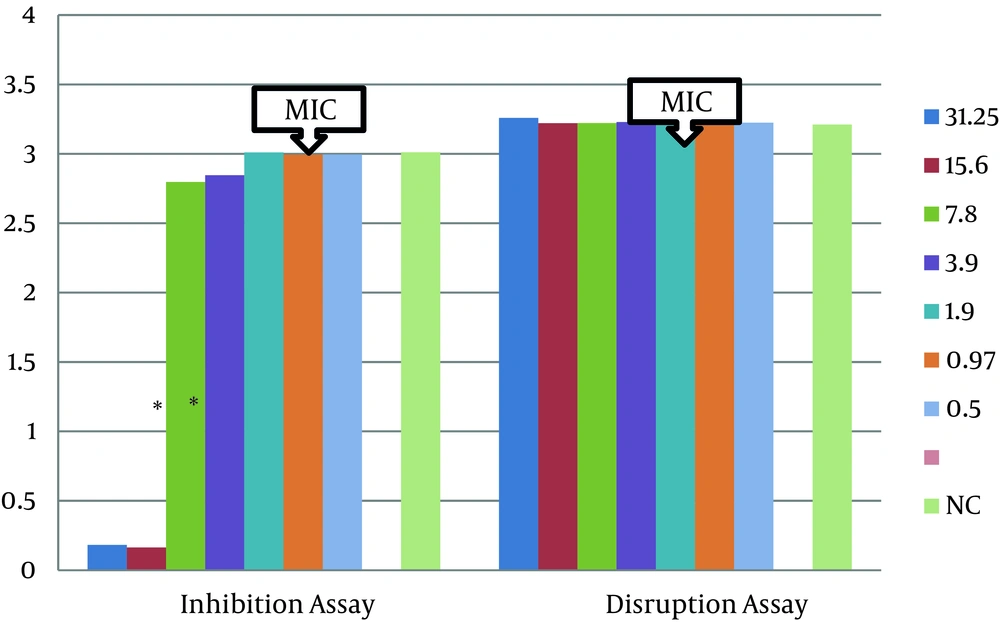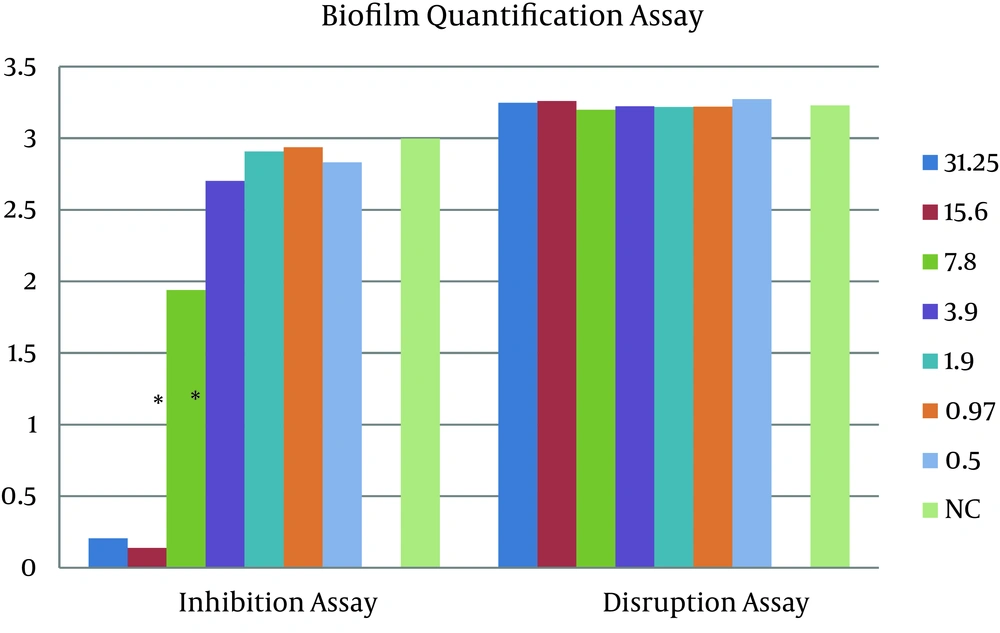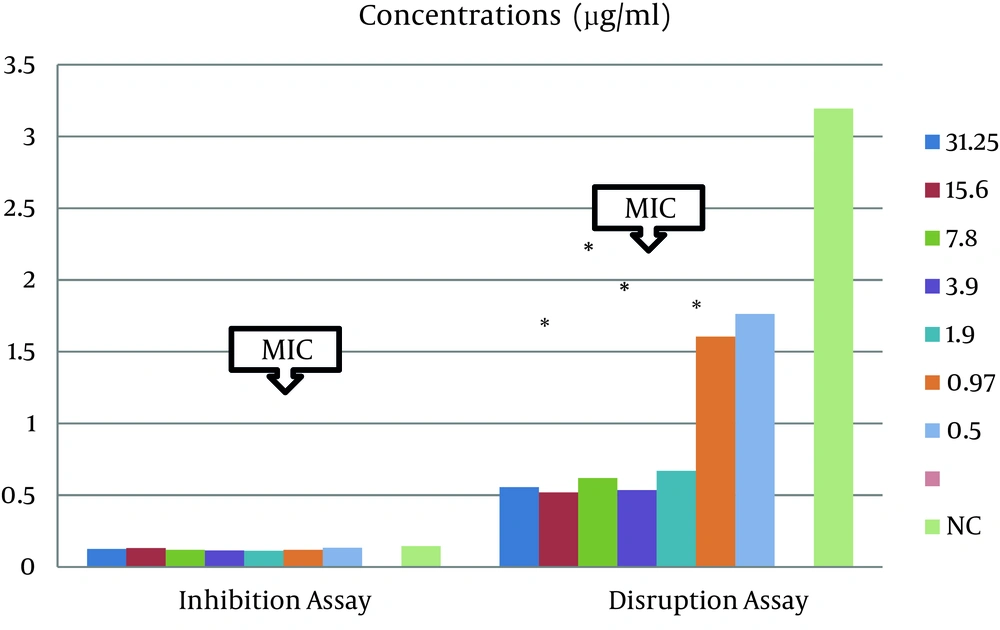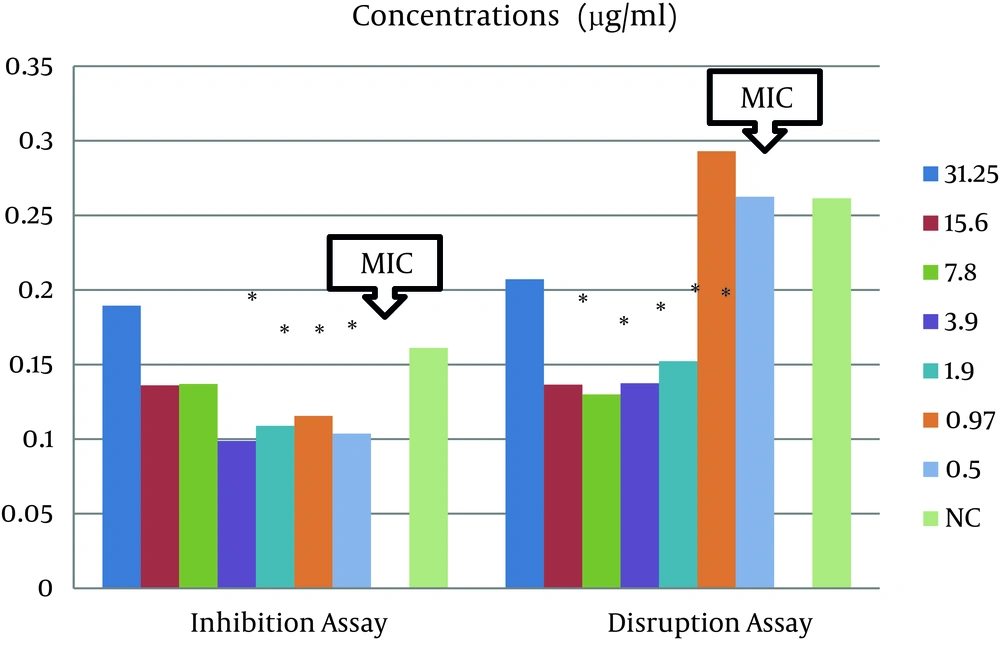1. Background
The human oral cavity is a complex environment inhabited by diverse microorganisms that mainly live on tooth subgingival and supragingival sites. At these oral sites, bacteria can colonize and accumulate as microbial communities known as dental biofilms or dental plaque. Although planktonic cells can easily be eliminated with antibiotic therapy, biofilms are more resilient and are a cause of many persistent infections and recontamination (1).
Changes in the composition of predominant biofilm species are believed to disturb the balance of the host and initiate oral diseases such as dental caries and periodontal disease (1). It is well established that dental caries are directly caused by cariogenic plaques, (2) compromised of low-pH streptococci, predominantly Streptococcus mutans, S. oralis and S. mitis. Other microorganisms including Rothia, Actinomyces, Lactobacilli and Bifidobacterium species (2, 3). Conversely, biofilms associated with susceptibility to periodontal disease, are mainly composed of Gram negative, anaerobic and capnophilic pathogens. The bacterial species in dental plaque have previously been classified into six color-coded bacterial complexes which determine the situation of the biofilm (healthy versus diseased) (3). The orange (Fusobacterium nucleatum, Porphyromonas intermedia, P. nigrescens), red (P. gingivalis, Tannerella forsythensis and Treponemes denticola) and green complex bacteria, (Aggregatibacter actinomycetemcomitans) of the subgingival plaque have been associated with periodontitis (3, 4).
The inhibition of biofilm formation and effective disruption of existing biofilms, on tooth surfaces and periodontal pockets, is a proper way for prevention and treatment of such oral diseases (5). Several studies have examined the inhibitory effect of antimicrobial agents, such as antibiotics, Fluorides, Povidone-iodine, Triclosan and Chlorhexidine on the bacterial grown on oral surfaces (5-7). However, these agents have some significant side effects including; gastrointestinal irritation, tooth staining and most importantly, risk of developing antimicrobial resistance (7, 8). Therefore, the detection of safe, novel and natural bioactive compounds that interfere with biofilm development and maintenance which simultaneously decrease the risk of bacterial resistance are critical.
Many edible and medicinal plants are known to have natural, antimicrobial properties such as phenolic compounds and their subclasses, coumarins, flavonoids, and essential oils (2, 9). Essential oils are natural volatile organic constituents of aromatic plants that contribute to its flavor and odor. In nature, they play an important role in the protection of plants against bacteria, viruses, fungi, insects and herbivores, by reducing their appetite to the plant. The most studied antimicrobial components of medicinal plants are carvacrol, that were previously found in several plants (10) and shown to have antimicrobial activity against many bacteria (9).
Plant-derived essential oil products have been studied in relation to pharmaceutical and therapeutical applications in different fields such as medicine and dentistry (11), food preservation, perfumes, cosmetics, aromatherapy, phototherapy, and nutrition (12). The antibacterial and antifungal activity of several essential oils such as peppermint (13), tea tree (14), manuka, lavandula (15) Satureja hortensis (11) and Shiitake mushroom extracts, have previously been tested on several pathogens such as; F. nucleatum, S. mutans, P. gingivalis,Actinomyces oris (formerly viscosus), P. intermedia, Staphylococcus aureus and S. sanguis (16).
2. Objectives
This study aimed to analyze the inhibitory and disruptive properties of Shiitake essential oil extracts chemical composition on oral biofilms and several oral pathogens associated with dental caries and periodontitis.
3. Materials and Methods
3.1. Extraction and Chemical Analysis of Essential Oils
The oil extract of Shiitake mushroom, a popular food product with certain medicinal properties, was isolated from finely ground dried Shiitake mushrooms (Hibika, China) by hydrodistillation for 3 hours and subsequently dried over anhydrous sodium sulphate (≥ 99.0%) (Sigma, Germany), as previously described (17). The qualitative and quantitative compositions of essential oil were analyzed by gas chromatography- mass spectrometry (GC-MS). GC–MS was performed using a TRACE ISQ (Thermo Scientific, USA) operated with a TR-5MS column (30 mm- 0.25 mm, film thickness 0.25 µm). The initial temperature of the column was set at 80oC and then increased to 280oC with a 7oC/min rate using the helium as the carrier gas. The identification of the chemical constituents was based on data obtained by the Wiley, Nist, and Tutor libraries spectra (11).
3.2. Bacterial Strains and Growth Conditions
Bacteria used in this study included P. gingivalis ATCC 33277, F. nucleatum ATCC 25586, A. actinomycetemcomitans FDC Y4 and S. mutans ATCC 25175. ATCC and FDC strains were kindly provided by Dr. Philip Bird, Queensland University, Australia and S. mutans from the culture collection of Yeditepe University, Turkey. Brain Heart Broth (BHB; Merck, Germany) was used for the growth and maintenance of microorganisms and BHB supplemented with 1 % sucrose used for the growth of bacterial biofilms. All bacteria were cultured and incubated under anaerobic conditions at 37°C (80% N2: 10% CO2: 10% H2 v/v) in an anaerobic work station (Don Whitley Scientific, UK) for 24 hours.
The bacterial stock suspensions used for antibacterial and biofilm assays, were prepared by centrifugation (3000 x g for 5 minutes) of overnight broth cultures. The harvested pellet was re-suspended in 10 mM phosphate buffered saline (PBS), pH 7.2 (Sigma, Germany) and subsequently, the turbidity was adjusted to 1.0 McFarland standard, equivalent to 3 X 108 CFU/mL. The multispecies stock culture was prepared by adding 1 mL of each prepared bacterial stock solution, to a final concentration of 3 X 108 CFU/mL.
3.3. Efficacy of Shiitake Oil on Planktonic Cells
Antimicrobial assays carried out according to CLSI guidelines (Clinical Laboratory Standards Institute, 2000) (18). Bacterial stock solutions previously grown in BHB were adjusted to 108 CFU/mL and 10 µL inoculated and cultured onto brain heart infusion agar (BHI) supplemented with 5% sheep blood (Salubris, Massachusetts, USA). Sterile, blank filter paper discs (6 mm in diameter) were impregnated with 15 µL of undiluted essential oil (125 mg/L) or chlorhexidine gluconate (CHX), (0.12 mg/mL), (Kloroben, Drogsan, Turkey) as a positive control and placed on the agar surface. Following anaerobic incubation at 37°C for 24 hours, diameters of inhibition zones were measured in millimeters. Each assay was repeated three times and antibacterial activity expressed as mean ± standard deviations of inhibition diameters.
The MIC and MBC were determined by preparation of two fold serial dilutions of Shiitake oil (0.5 - 31.25 µg/mL) in BHB, supplemented with 0.1 % Tween 80 to increase solubility of the oil in the medium. One hundred µL of the solution was inoculated into each well of a 96-well flat-bottom microtitre plate (TPP, Switzerland) and 100 µL per well, of bacterial suspension at a final concentration of 1.5 X 105 CFU/mL (confirmed by viable counts) were added. Controls included: a negative control of medium and bacteria only; a blank medium with Shiitake mushroom oil and a positive control of CHX. Plates were incubated anaerobically at 37°C for 24 hours. The absorbance was measured at 595 nm using a microplate reader (ThermoLab Systems, Germany). The MIC was defined as the lowest concentration of Shiitake oil at which no visible growth (O.D595nm < 0.05) was detected. To measure the MBC, 5 µL of inoculums were incubated on BHI medium for 24 hours. The MBC was defined as the lowest concentration at which the original growth was reduced by ≥ 99.9%.
3.4. Biofilm Inhibition Assay
The colorimetric assay by crystal violet staining (11) was performed for the quantification of biofilm inhibition. One hundred microliters of bacterial solution (1.5 X 105 CFU/mL) and Shiitake mushroom oil (31.25- 0.5 µg/mL), prepared as described for MIC and MBC, were inoculated into each well of a flat bottom 96-well plate (TTP, Germany). Negative and positive controls included bacteria with medium and CHX (0.12 mg/mL), respectively. Following 24 hours anaerobic incubation at 37°C, growth was confirmed by a microplate absorbance reading at 595 nm. Subsequently, planktonic cells were removed from each well by washing three times with PBS, pH 7.2 (Sigma, Germany), and then stained for 1 minute with 200 μL of 0.14 % crystal violet (Sigma, Germany). Stained biofilms were washed with water and air dried. The amount of crystal violet binding was quantitated by resuspending in 200 μL PBS and OD595 measured by using a microplate reader. Each assay was repeated three times. As a measure of efficacy, relative biofilm formation was defined as follows:
[(OD595 treated well) / (mean OD595 control well) x 100)] (11).
3.5. Biofilm Disruption Assay
The disruption effect on established 24-hour biofilms was investigated for all the species and multispecies cultures. Bacterial inoculums were prepared and plated (100 µL) into a 96-well plate as described for the inhibition assay. The test agent, Shiitake mushroom oil was excluded from all wells at this stage. A negative control of medium only cultured with bacteria and a positive control of CHX were included in each plate. Following a 24-h anaerobic incubation, 100 µL of Shiitake mushroom oil dilutions (0.5 - 31.25 µg/mL) were inoculated into each well of the established biofilms. Microplates were subsequently incubated anaerobically for further 24 hours and then stained with 0.1 % crystal violet and quantified at OD595 nm as for the inhibition assay. Biofilm disruption was calculated by quantification of biofilm formed using the following formula:
[(OD595 treated well) / (mean OD595 negative control well) x 100)] (11).
3.6. Cytotoxicity Analysis
HaCaT human skin keratinocytes (CLS, Germany) were cultured under 5% CO2 at 37 °C on Dulbecco's Modified Eagle's Medium (DMEM), (Gibco, USA) containing 10% fetal calf serum (FCS), (Gibco, USA), 1% l-glutamine (Gibco, USA), and 1% Penicillin G (Gibco, USA). Cells were grown in 96-well plates to full confluence. Following washing twice with PBS, fresh medium was added in each well and the essential oils were inoculated into the culture medium at different concentrations ranging from 0.8% to 50%. After a 24-hour incubation, the medium of well was collected and the cytotoxic effect was measured with a commercially available cytotoxicity detection kit (Roche, Germany) to measure the lactate dehydrogenase level in the culture media.
3.7. Statistical Analysis
All experiments were performed in triplicate and results expressed as means ± standard deviations. The effect of different Shiitake mushroom essential oil concentration on epithelial cell viability and biofilm assays were analyzed using Student’s t-test. P values of 0.05 or less were considered significant (SPSS version 10, UK).
4. Results
4.1. Compositional Analysis and Antimicrobial Assays
Several known antimicrobial plant compounds were detected in Shiitake mushroom oil with the predominant constituent of carvacrol (62.75%), (Table 1). Antimicrobial compounds of eugenol (1.19%) and thymol (3.03%) were also observed in lower concentrations.
| RT a | Compound Name | Area, % |
|---|---|---|
| 4.58 | O- Cymene | 1.15 |
| 5.07 | Gamma-terpenine | 1.39 |
| 5.23 | 1- phenylethanol | 1.44 |
| 5.38 | Acetophenone | 1.81 |
| 5.45 | P- tolualdehyde | 5.37 |
| 5.70 | para-tolualdehyde | 0.63 |
| 6.16 | 11,2,4- Trithiolane | 3.61 |
| 6.50 | 4- methylbenzyl alcohol | 2.07 |
| 9.26 | Thymol | 3.03b |
| 9.43 | Carvacrol | 62.75b |
| 10.46 | Eugenol | 1.19 b |
| 11.71 | trans- Caryohyllene | 4.10 |
| 12.10 | alpha-humulene | 0.42 |
Relative Chemical Components of Essential Oil of Shiitake
In the present study, the in vitro effects of Shiitake mushroom ( L. edodes), were investigated for its antimicrobial and antibiofilm properties. Disc diffusion results of Shiitake mushroom oil (Table 2) displayed antimicrobial activity (≥ 10 mm) against all tested microorganisms. The most effective antimicrobial activity was observed against A. actinomycetemcomitans , P. gingivalis and F. nucleatum, respectively.
| Bacterial Species | Inhibition diameters, mm (125 mg/L) | MIC (w/v), µg/mL | MBC (w/v), µg/mL |
|---|---|---|---|
| S. mutans | 10,4 ± 1 | 1.95 | 15.6↑ |
| A. actinomycetemcomitans | 18,8 ± 2,5 | 3.9 | 31.25↑ |
| F. nucleatum | 12,5 ± 0,2 | 31.25 | 31.25 |
| P. gingivalis | 13,6 ± 1,2 | 0.5 | 7.8↑ |
| Multispecies | - | 1.95 | 15.6↑ |
Inhibition Diameters, MICs and MBCs of Shiitake Essential Oil Against Tested Bacteria
The MIC of Shiitake mushroom oil ranged from: 0.50 to 31.25 µg/mL (Table 2), the P. gingival is displaying the highest susceptibility at a low concentration of 0.5 µg/mL. The least sensitive MIC value of 31.25 µg/mL, was observed with F. nucleatum.
4.2. Biofilm Quantification Assays and Cytotoxicity Analysis
No significant antibiofilm effect of Shiitake mushroom oil was observed against F. nucleatum at all tested concentrations ( P > 0.05). Shiitake mushroom essential oil at concentrations of 31.25 and 15.6 µg/mL were able to significantly inhibit the formation of S. mutans (Figure 1) and multispecies culture biofilms (Figure 2) ( P < 0.05).
The identical results for these two tested cultures were previously observed on the MIC and MBC values and showed the importance of S. mutans eradication in multispecies biofilms.
Although Shiitake mushroom oil did not affect the formation of A. actinomycetemcomitans biofilms, early developed biofilms were significantly unsettled at concentrations ranging from 1.95 - 31.25 µg/mL (Figure 3) (P < 0.05).
The best efficacy of Shiitake essential oil in terms of significant biofilm inhibition and disruption was observed for P. gingivalis (Figure 4). Shiitake oil showed considerable inhibition activity on P . gingivalis biofilms at concentrations ranging from 0.97 - 31.25 µg/mL, which were slightly above the MIC of planktonic counterpart bacteria. Furthermore, concentrations of 1.95 to 15.6 µg/mL were seen to significantly reduce 24-hour biofilms ( P < 0.05).
Shiitake essential oil did not show any cytotoxic effect against HaCaT cells (P > 0.05). At the highest concentration of 50%, only minimal detachment of keratinocytes was observed (approximately 10 %).
5. Discussion
Although some studies (19-21) have demonstrated the bactericidal effect of supercritical (3) and chemical solvent of the extracted Shiitake mushroom on oral pathogens, the antimicrobial activity of Shiitake mushroom oil extracts has not been previously reported.
The major antimicrobial component of carvacrol found in this study, is a known aromatic monoterpene, shown to actively disintegrate the outer membrane of Gram-negative bacteria by releasing lipopolysaccharides from the bacterial cell wall and increasing the membrane permeability (22). Carvacrol has been found in high amounts in other plants such as Satureja hortensis L. (11) and has previously exhibited significant antimicrobial activity against a wide range of microorganisms including (23) anaerobic oral pathogens. Other known antimicrobial compounds (thymol and eugenol), observed in reduced amounts have also been approved for their antimicrobial activity by altering membrane permeability (24).
Shiitake mushroom oil showed MBC values higher than their MIC with the exception of F. nucleatum. These findings indicated that only an inhibitory effect rather than bactericidal effect occurred with values lower than the corresponding MBC concentrations. MBC ranged from 0.50 µg/mL to 31.25 µg/mL. Interestingly, MIC and MBC of S. mutans and the multispecies culture showed the same values suggesting that the efficiency of the oil did not decrease in a mixed culture. This indicating that S. mutans is the predominant species in the multispecies cultures and a known important first colonizer of oral biofilms (25, 26), inhibition of S. mutans could result in inhibition of other microorganisms in the co-culture.
Concentrations at and below the MIC did not display a significant reduction in biofilm formation process and no disruption of preformed biofilms was observed at any oil concentration. This was expected, since the biofilm bacteria may have some phenotypic features that are not evident in their planktonic counterparts. These include; increased rates of genetic exchange among other biofilm residents and increased resistance to external factors such as antibiotics, detergents, UV exposure, dehydration, salinity and phagocytosis (26).
It was observed that concentrations lower than the MIC value (subinhibitory) (1.95 µg/mL), significantly reduced the preformed biofilms of A. actinomycetemcomitans. These findings are considerably important, since established biofilms have greater resistance to the external agents (27). Therefore, disruption of pre-formed biofilms tends to have higher MIC values. According to Marsh (28), to assume an agent as specific anti- biofilm agent, it should be effective on biofilms at dose ranges lower than the MIC since at these doses, the specific tested agents do not kill the bacteria but take a different mode of action, resulted in reduced adherence and membrane disruption.
Inhibition of early preformed biofilms of oral pathogens, have previously been observed using carvacrol, the major antimicrobial component of Shiitake oil and many plant extracts (11). The antibiofilm effects of Shiitake essential oil have not been previously reported. To date, the study of Yano et al. is the only report showing the ability of extracts from Shiitake mushroom to inhibit the sucrose-dependent formation of biofilms and to eliminate the preformed biofilms (29).
In conclusion, Shiitake essential oil extract showed significant biofilm inhibitory and disruptive effects on single and mixed cultures. As the limits of this in vitro study, it can be concluded that with consideration of its significant, antibiofilm and non cytotoxic properties on key oral pathogens, Shiitake essential oil could be useful as an alternative therapeutic strategy against biofilm-related oral diseases such as periodontitis.



